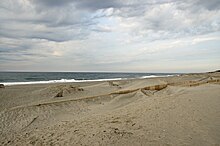Sand fence
Sand fences are also commonly employed following storm events in order to aid in the dune recovery process,[1] particularly in developed areas where dunes are critical for protection of property.
[2] A typical construction is to attach a perforated plastic sheet to stakes at regular intervals, similar to construction site fencing or temporary sports field fencing.
Another is a cedar or other lightweight wood strip and wire fence, also attached to metal stakes.
The drifting and settling of sand behind and in front of such a fence occurs because the wind speed on both the downwind and windward sides is less than that on the far windward side, allowing light materials such as sand to settle.
Conveniently the sand does not drop on the barrier itself, otherwise it would soon be buried and rendered useless.

